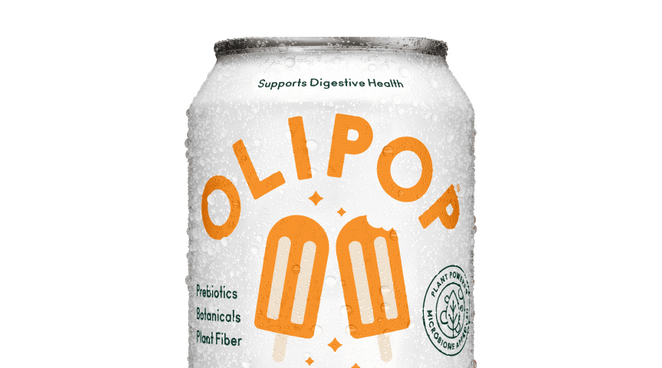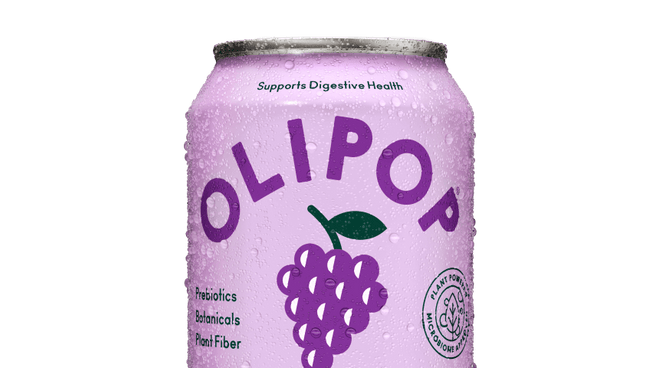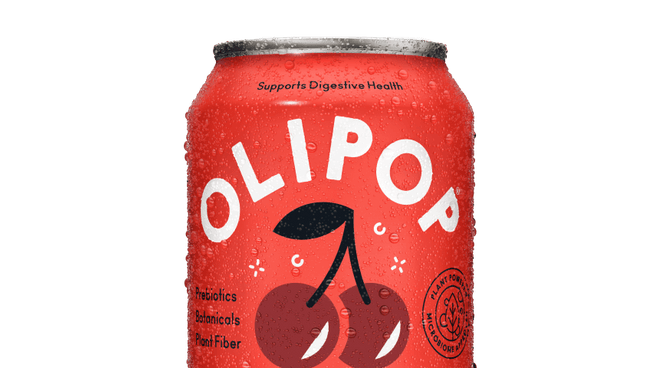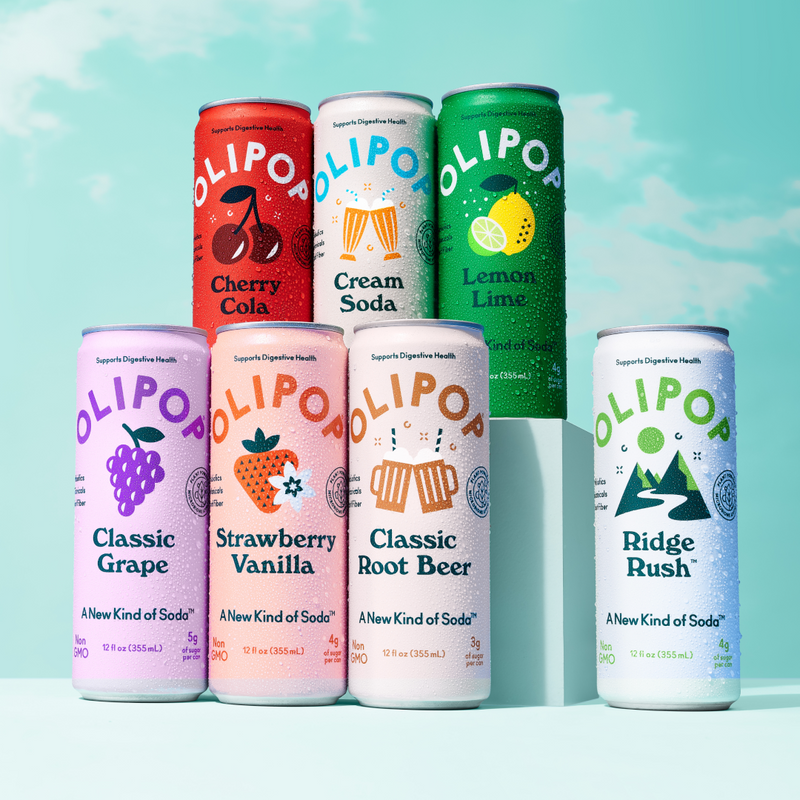Whether you're on the hunt for a tasty treat or you’re embarking on the keto diet, OLIPOP has got you covered! Our fun, fizzy tonics are non-GMO, vegan, gluten-free, paleo, and keto-friendly.
Learn more about the keto diet and what makes our drink the perfect soda for the keto dieter:
What Is Keto?
The keto diet is a low-carb, high-fat diet that aims to put your body into a state of ketosis where you’re burning fat instead of carbs. The keto diet flips the food pyramid upside down with an ideal food ratio of 75% fats, 20% protein, and only 5% carbs.

The diet got its start back in the 19th century as a method for managing diabetes. In the 1920s, doctors used the diet as a treatment plan for children with epilepsy.1 Today, keto rests solidly in the fad diet category as a popular weight-loss strategy.
While it can result in weight loss in the short term, this restrictive diet is often hard to maintain for the long term. It's also important to keep in mind that by cutting out most carbs means that you’re also cutting out a lot of needed nutrients, vitamins, and fiber from your diet.2
How Does the Keto Diet Work?
The whole idea behind keto is that if you deprive your body of its preferred energy source, glucose, it’ll turn to an alternative fuel source from your fat instead, called ketones. This process is called ketosis, which is when your body doesn’t have carbs to break down into glucose and instead starts burning fat.3
With keto, you’re essentially putting your body in a fasting state. Without glucose, the next source of energy that your body turns to in a state of starvation is muscle tissue. It’ll break down your muscles to release stored glucose.1 But with keto, you’re providing your body with enough protein to ideally avoid the breakdown of muscle tissue. This forces the body to skip to its third source of energy instead: ketones.2
While it sounds simple, in reality, it’s hard to get into and maintain a state of ketosis. The diet requires strict adherence.2 This is because your brain and body prefer glucose over any other form of energy. So as soon as you provide your body with enough carbohydrates, it’ll switch right back to burning glucose instead of fat.
To avoid this, most keto diets recommend no more than 50g of total carbs or 30g of net carbs per day.4
Net Carbs vs. Total Carbs
Because fiber is an indigestible carbohydrate, the distinction of “net carbs” and “total carbs” was created as a way to break out which carbs actually contribute to calories.
- Total carb: The total count of all carbohydrates in a food item, including fiber
- Net carbs: Only counts the carbohydrates in a food item that contribute to calories (or total carbohydrates minus fiber)
To calculate net carbs you subtract dietary fiber from total carbohydrates. The net carb count of our Classic Grape, for example, would be 6g (15g – 9g).

Keto Diet Food Groups
For keto to work, it’s important to know what foods you can and cannot eat to maintain a fat-burning state of ketosis. You’ll want to fill up most of your plate with fats, a little bit of protein, and as few carbs as possible.
Fats: 75%
Fats should make up 75% of your keto diet. This means most of the food you’re eating should be high-fat foods such as:2 5
- Nuts and seeds (e.g. almonds, walnuts, flax seeds, pumpkin seeds, chia seeds)
- Avocados
- Olives
- Healthy oils (e.g. extra virgin olive oil, coconut oil, avocado oil)
- Dairy (cheese, butter, Greek yogurt, heavy cream)
- Fatty fish (mackerel, salmon, tuna)
Protein: 20%
Protein makes up 20% of the keto diet. So less than ¼ of your plate should consist of foods like:2
- Fish
- Eggs
- Poultry
- Lean meats
Carbs: 5%
Less than 5% of your diet should come from carbs. This means you should limit these high-carb foods on a keto diet:1 2 6 7
- Fruit (because of their sugar content, most fruits can throw you out of ketosis)
- Refined and whole grains (bread, cereal, pasta, rice)
- Starchy vegetables (peas, potatoes, corn, squash)
- Legumes (beans, lentils, peanuts)
- Added and natural sugars (look for sugar alternatives like the cassava root syrup, sweet birch, real fruit juice, and stevia you’ll find in OLIPOP!)
- High-carb alcohol (beer, cocktails, and some wine)
There are some low-carb veggies that most keto diets approve, such as:5 7
- Broccoli
- Cauliflower
- Cabbage
- Green beans
- Tomatoes
- Brussels sprouts
- Cucumbers
- Celery
- Leafy greens (e.g. arugula, kale, spinach)
- Peppers
Are There Risks or Side Effects With the Keto Diet?
Yes! As you can see, the keto diet cuts out some pretty healthy food groups like whole grains, fruits, and some veggies.
It’s important to replace the nutrients that you’re missing from these food groups with other types of food. Otherwise, this diet can result in harmful nutrient deficiencies.1 Some common deficiencies for keto dieters include fiber, calcium, vitamin D, selenium, magnesium, zinc, and phosphorus.1 3
There are also a few common keto side effects that many people experience when starting a keto diet:1 3
- Hunger
- Fatigue
- Bad breath
- Low mood
- Irritability
- Trouble sleeping
- Constipation
- Headaches
- Nausea
- Brain “fog”
- Dehydration
Many keto dieters call these symptoms the “keto flu”. They tend to subside after a week or so. But if you’re experiencing these symptoms longer than a week, we recommend stopping the diet right away and speaking with a doctor.
In fact, before you even begin the keto diet, or any diet, it’s always a good idea to speak with your doctor or dietitian first.
Is OLIPOP Keto-Friendly?
Yes, OLIPOP is keto-friendly!
Here’s what makes us a keto-friendly beverage, unlike other soda brands:
- Low carb: OLIPOP only has 6-7g of net carbs per can!
- Minimal sugar: Sugar is a carbohydrate, making most high-sugar soda beverages a big no for the keto diet. But not OLIPOP, with only 2-5g of sugar in each can.
- Natural ingredients: Instead of high fructose corn syrup, we sweeten our soda with natural ingredients like cassava root syrup, sweet birch, and stevia that contribute very little carbs and sugar to the keto diet.
- High fiber: Any low-carb diet puts you at risk of not getting enough fiber. But with OLIPOP you can add extra fiber to your diet with every can.
Because keto is an incredibly restrictive diet, it can become unhealthy if you’re not getting enough necessary vitamins, minerals, and fiber. With OLIPOP, you can add back in a lot of the nutrients that you’re missing from cutting out carbs.
Generally, we think the foods and drinks you put in your body should be pleasurable and not restrictive, but if you’re embarking on the keto diet, we’re here in your fridge to help you along the way.
Want to learn more about all the reasons why OLIPOP can be your healthier soda alternative? Check out OLIPOP Digest for all the latest resources, research, and information.
Sources
- Harvard T.H. Chan School of Public Health. (2019, May 22). Diet Review: Ketogenic Diet for Weight Loss. The Nutrition Source. Retrieved March 25, 2022, from https://www.hsph.harvard.edu/nutritionsource/healthy-weight/diet-reviews/ketogenic-diet/
- Freels, K. (2019, April 10). What is the Keto Diet? National Center for Health Research. Retrieved March 25, 2022, from https://www.center4research.org/keto-diet/
- Kalra, S., Gupta, L., Khandelwal, D., Gupta, P., Dutta, D., & Aggarwal, S. (2017). Ketogenic diet in endocrine disorders: Current perspectives. Journal of Postgraduate Medicine, 63(4), 242. https://doi.org/10.4103/jpgm.jpgm_16_17
- Mayo Foundation for Medical Education and Research. (2021, March 3). The truth behind the most popular diet trends of the moment. Mayo Clinic. Retrieved March 25, 2022, from https://www.mayoclinic.org/healthy-lifestyle/weight-loss/in-depth/the-truth-behind-the-most-popular-diet-trends-of-the-moment/art-20390062?reDate=25032022
- Mawer, R. (2020, October 22). The Ketogenic Diet: A Detailed Beginner’s Guide to Keto. Healthline. Retrieved March 25, 2022, from https://www.healthline.com/nutrition/ketogenic-diet-101
- University of California San Francisco. (2018, August 31). As the Keto Diet Gains Popularity, Scientists Explain What We Do and Don’t Know. Retrieved March 25, 2022, from https://www.ucsf.edu/news/2018/08/411526/keto-diet-gains-popularity-scientists-explain-what-we-do-and-dont-know
- Miller, K., & Shiffer, E. (2021, April 2). 20 Keto Vegetables To Eat When You’re Going Low-Carb. Women’s Health. Retrieved March 25, 2022, from https://www.womenshealthmag.com/weight-loss/g25656443/keto-vegetables/
- Low carb: OLIPOP only has 6-7g of net carbs per can!
- Sugar is a carbohydrate, making most high-sugar soda beverages a big no for the keto diet. But not OLIPOP, with only 2-5g of sugar in each can.
- Instead of high fructose corn syrup, we sweeten our soda with natural ingredients like cassava root syrup, sweet birch, and stevia that contribute very little carbs and sugar to the keto diet.
- Any low-carb diet puts you at risk of not getting enough fiber. But with OLIPOP you can add 9g of fiber to your diet with every can.














